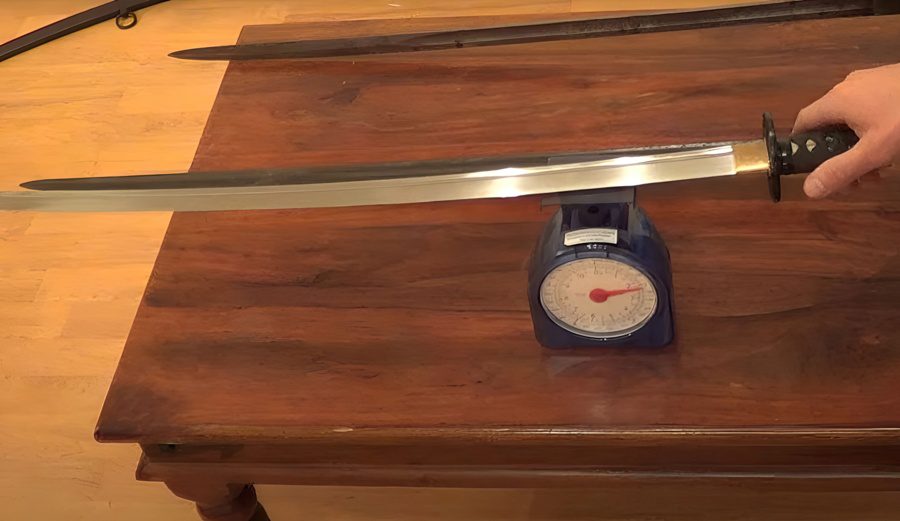How Much Does a Katana Weigh?

What’s in this article?
The weight of the katana sword is the most important factor when using it for either kata cutting practice on a tameshigiri, honing the kamae stances, and determining its authenticity. Getting the right weight for a katana sword will also impact and change the entire feel and function of the blade.
In this article, we will present the traditional weight of the Katana sword. We will then discuss the contributing factors with a chart in which the height and weight ratio will be calculated for better and easier understanding.
The Weight of a Katana Sword

The traditional weight of a functional two-handed 39-inch (100 cm) Japanese katana sword is from 2.1 to 2.75 lbs (0.95 to 1.25 kg). This weight point can vary higher or lower by 0.45 lbs (200 g) depending on the katana’s length, whether a smaller ko-katana or a larger o-Katana sword.
This weight point was taken as a standard during the peaceful Edo Period of Japan, where roughly 200 years of peace made the katana more of a refined dress piece and a symbol of social status than a tool of war. For example, rather than using the heavier blade as an effective cutting tool during the Muromachi Era (1394-1595), the katana’s weight in the Edo period (1596-1867) became lighter. It was used primarily for cutting tests or unarmored duels.
Depending on the era’s construction of the katana?because Shinto and Koto (old and new) steels differ, as well as the different craftsmanship schools manufacturing it?the weight of the katana can vary. Many other factors can also contribute to the weight of the sword.
Factors That Contribute to the Weight of the Katana

The Samurai katana sword is made up of many different pieces that make it function as one of the most powerful and precise cutting swords in history. Each of these pieces plays a crucial part in the overall weight of the sword.
- Koshirae Fittings – the tsuka handle and tsuba handguard are made up of many different fittings and mountings that can differ in size or material and give a different weight
- Metal – different types of metals used while crafting the sword result in different weights. This is primarily due to the density and thickness of the steel while crafting. For example, spring steel has more density than a regular carbon steel
- Bohi Groove – by taking out a chunk of steel from the blade, a fuller is made, which makes the weight of the sword lighter
- Type – depending on the type of katana, whether larger (o-katana) or smaller (ko-katana), the weight can vary significantly
- Scabbard – when added to the blade, the saya scabbard can increase the overall weight of the katana sword by around 0.44 lbs (200 grams)
- Function – a traditional and battle-ready Samurai katana for cutting tests will have a different weight than an iaito katana made for training, or a decorative Katana made for cosplay or LARP (live-action roleplay) purposes
Katana Length-to-Weight Ratio
Functional Steel Katana Swords
| Length | Weight |
|---|---|
| 39 inches (100 cm) < | as low as 1.5 lbs (0.68 kg) |
| ~ 39 inches (100 cm) | 2.1 to 2.75 lbs (0.95 to 1.25 kg) |
| 39 inches (100 cm) > | as high as 3.4 lbs (1.55 kg) |
While length is an important factor for determining the katana sword’s final weight, it isn’t the only one. Despite that, as a general rule of thumb, the weight of a functional steel katana sword with or without a fuller can be calculated by following the chart shown above.




